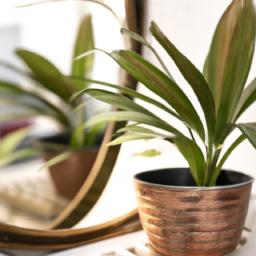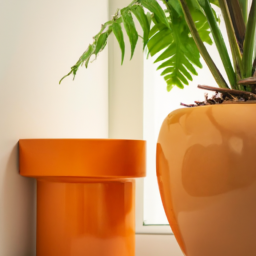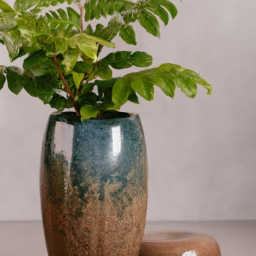
Are you a plant enthusiast looking to add some greenery to your living space? If so, you’ve probably come across the dilemma of choosing between indoor and outdoor plant pots. The decision may seem simple, but there are several factors to consider before making your choice. In this blog post, we’ll explore the pros and cons of both indoor and outdoor plant pots, helping you make an informed decision that suits your specific needs and preferences. So, let’s dive in and discover the world of indoor vs outdoor plant pots!
Benefits of Indoor Plant Pots vs Outdoor Plant Pots
When it comes to gardening, choosing the right plant pots is essential for the health and growth of your plants. Whether you are an experienced gardener or just starting out, understanding the benefits of indoor and outdoor plant pots can make a significant difference in the success of your gardening endeavors. In this guide, we will explore the advantages of both indoor and outdoor plant pots, helping you make an informed decision for your specific needs.
Indoor Plant Pots
Indoor plant pots have gained immense popularity in recent years, and for good reason. They offer a range of benefits that make them a preferred choice for many garden enthusiasts.
First and foremost, indoor plant pots allow you to bring nature inside your home. They create a refreshing and calming environment, enhancing the aesthetics of your living space. With a wide variety of plant species available for indoor gardening, you can easily find plants that suit your taste and complement your interior design.
Moreover, indoor plant pots provide better control over the growing conditions. You can regulate the temperature, humidity, and light levels to create an optimal environment for your plants. This control is particularly beneficial for delicate or exotic plants that require specific conditions to thrive.
Indoor plant pots also offer convenience. They can be placed anywhere in your home, from windowsills to shelves, allowing you to maximize the available space. Additionally, they are portable, which means you can easily move them around to experiment with different placements and find the perfect spot for your plants.
Another advantage of indoor plant pots is the reduced risk of pests and diseases. Since indoor plants are shielded from external factors like insects, harsh weather, and soil-borne diseases, they are less likely to be affected by such issues. This makes indoor gardening a low-maintenance and hassle-free option for plant lovers.
Outdoor Plant Pots
While indoor plant pots have their own set of benefits, outdoor plant pots offer unique advantages that make them a preferred choice for many gardeners.
One of the key benefits of outdoor plant pots is the ample space they provide for plant growth. Outdoor gardens allow plants to spread their roots freely, resulting in healthier and more robust growth. This is particularly beneficial for large plants or those that require extensive root systems.
Furthermore, outdoor plant pots offer natural sunlight, which is essential for photosynthesis. Sunlight provides plants with the energy they need to produce food, promoting vigorous growth and vibrant blooms. Outdoor gardens also expose plants to natural air circulation, which helps prevent the build-up of moisture and reduces the risk of fungal diseases.
Outdoor plant pots also offer a wider range of plant options. Since outdoor plants are not confined to limited space, you can grow a variety of plants, including larger trees, shrubs, and flowering plants. This diversity allows you to create a visually stunning garden with different colors, textures, and heights.
In addition, outdoor plant pots promote biodiversity. By attracting pollinators like bees and butterflies, outdoor gardens play a crucial role in supporting local ecosystems. They contribute to the overall health of the environment and help maintain a balance in the natural world.
Lastly, outdoor plant pots provide a sense of connection with nature. Spending time outdoors, tending to your garden, and witnessing the growth and transformation of plants can be a therapeutic experience. It allows you to escape the confines of indoor spaces and reconnect with the beauty and serenity of the natural world.
Conclusion
Choosing between indoor and outdoor plant pots depends on various factors such as available space, plant preferences, and the desired gardening experience. Indoor plant pots offer convenience, control, and aesthetics, making them an excellent choice for those who want to bring nature inside their homes. On the other hand, outdoor plant pots provide ample space, natural sunlight, and biodiversity, offering a more traditional gardening experience. Ultimately, the decision comes down to your personal preferences and the specific needs of your plants. So, go ahead, select the right plant pots, and embark on a rewarding gardening journey!

Factors to Consider When Choosing Between Indoor and Outdoor Plant Pots
When it comes to choosing plant pots, whether for indoor or outdoor use, there are a few factors that need to be considered. The right pot can make a significant difference in the growth and health of your plants. In this guide, we will walk you through the important factors to consider when making a decision between indoor and outdoor plant pots.
1. Material
The material of the pot plays a crucial role in determining its suitability for indoor or outdoor use. For indoor plants, you can opt for a wide range of materials such as ceramic, terracotta, or even plastic. Ceramic and terracotta pots are popular choices due to their aesthetic appeal and ability to retain moisture. Plastic pots, on the other hand, are lightweight and easy to clean.
When it comes to outdoor plants, durability becomes a key factor. Clay pots are a great choice for outdoor use as they are sturdy and provide good insulation for the roots. They are also more resistant to extreme weather conditions. Another option is fiberglass pots, which are lightweight, weather-resistant, and can mimic the look of other materials like stone or concrete.
Consider the specific needs of your plants and the climate in your area when choosing the material for your plant pots.
2. Drainage
Proper drainage is essential for the health of your plants. Indoor plants often require pots with drainage holes to prevent waterlogging and root rot. Excess water can easily be drained out, ensuring that the roots remain healthy and oxygenated. Look for pots with drainage holes or consider using a layer of gravel or pebbles at the bottom of the pot to facilitate drainage.
On the other hand, outdoor plants may not require drainage holes as the excess water can be naturally drained into the soil. However, if you live in an area with heavy rainfall, it is still advisable to choose pots with drainage holes to prevent water accumulation during downpours.
Remember to check the drainage capabilities of the pots you are considering to ensure the well-being of your plants.
3. Size and Space
The size of the pot is an important consideration for both indoor and outdoor plants. Indoor plants generally require smaller pots as they have limited space to grow. It is crucial to choose a pot that provides enough room for the roots to spread and grow. If the pot is too small, the roots may become root-bound, inhibiting the plant’s growth.
Outdoor plants, on the other hand, can be grown in larger pots to allow for more extensive root systems. This helps the plants establish a stronger foundation and withstand harsh weather conditions. Additionally, larger pots provide more stability, reducing the risk of plants tipping over during strong winds.
Consider the size of your plants and the available space, both indoors and outdoors, before selecting the appropriate pot size.
Conclusion
Choosing between indoor and outdoor plant pots requires careful consideration of various factors. The material, drainage capabilities, and size of the pots are all important aspects to keep in mind. By understanding the specific needs of your plants and the conditions they will be exposed to, you can make an informed decision that will promote healthy growth and enhance the overall aesthetic appeal of your plants.

Tips for Choosing the Right Indoor or Outdoor Plant Pots
When it comes to gardening, choosing the right plant pots is crucial for the health and growth of your plants. Whether you are an indoor or outdoor gardener, the type of pots you select can make a significant difference. In this guide, we will explore some essential tips to help you make the right choice for your indoor or outdoor plants.
Material Matters
The first consideration when choosing plant pots is the material. Different materials have varying effects on plant growth and maintenance. Here are some popular options:
Terracotta: Terracotta pots are a classic choice for both indoor and outdoor gardening. They are made from baked clay and have excellent breathability, allowing air and moisture to pass through the pot walls. This feature helps prevent overwatering and root rot. However, terracotta pots can be prone to cracking in freezing temperatures, so they might not be suitable for extremely cold climates.
Plastic: Plastic pots are lightweight, affordable, and available in various sizes and colors. They are a popular choice for indoor gardening due to their durability and versatility. Plastic pots retain moisture well, which can be advantageous for plants that require consistent watering. However, they may not be the best option for outdoor use as they can deteriorate under prolonged exposure to sunlight.
Ceramic: Ceramic pots are known for their aesthetic appeal. They come in a wide range of colors, shapes, and sizes, making them perfect for adding a decorative touch to your indoor plants. However, ceramic pots are generally heavier and more fragile than other materials. They can also be more expensive. It’s important to note that ceramic pots may not have drainage holes, so you need to be cautious with watering to prevent waterlogging.
Size and Drainage
When selecting plant pots, size matters. The size of the pot should be appropriate for the plant’s root system and growth potential. A pot that is too small can restrict root growth and lead to stunted plants, while a pot that is too large can cause overwatering and root rot.
Additionally, proper drainage is crucial for plant health. Ensure that your pots have drainage holes at the bottom to allow excess water to escape. If a pot doesn’t have drainage holes, you can create them yourself using a drill. Without proper drainage, water can accumulate at the bottom, leading to root rot and other fungal diseases.
When it comes to outdoor plant pots, it’s important to consider the weather conditions in your area. If you live in a region with heavy rainfall, it’s advisable to choose pots with larger drainage holes to prevent waterlogging during storms.
Consider Your Plant’s Needs
Each plant has unique requirements, and considering these needs is vital when selecting the right pots. Some plants prefer a drier environment, while others thrive in moisture-rich conditions. Research the specific needs of your plants and choose pots that can accommodate those requirements.
For example, succulents and cacti prefer well-draining soil and pots that allow excess water to evaporate quickly. These plants are better suited to terracotta pots that provide excellent breathability and prevent water accumulation.
On the other hand, tropical plants and ferns thrive in high humidity. Choosing pots with plastic or ceramic materials can help retain moisture and create a suitable environment for these plants.
Consider the growth potential of your plants as well. If you have plants that tend to outgrow their pots quickly, it’s wise to choose pots with a larger size or ones that can be easily repotted.
By considering the specific needs of your plants, you can ensure their optimal growth and overall well-being.
Conclusion
Choosing the right plant pots is an essential aspect of gardening, whether you are tending to indoor or outdoor plants. The material, size, drainage, and considering your plant’s needs are all crucial factors to consider. By following these tips, you can make informed decisions and provide the best environment for your beloved plants.
Let’s wrap up what we learned
When it comes to gardening, one of the key decisions you’ll need to make is whether to use indoor or outdoor plant pots. While both options have their pros and cons, it ultimately depends on your specific needs and preferences. Indoor plant pots are perfect for bringing a touch of nature into your home, adding a pop of color and freshness to any room. They come in various sizes, shapes, and materials, allowing you to find the perfect fit for your interior decor. Plus, with indoor pots, you have the flexibility to move your plants around to find the ideal spot for them to thrive.
On the other hand, outdoor plant pots offer a whole different set of advantages. They are designed to withstand the elements, making them a durable option for your garden or patio. Outdoor pots come in a wide range of materials, from terracotta to plastic, each with its own benefits. They provide proper drainage for your plants, preventing waterlogging and ensuring healthy growth. Additionally, outdoor pots allow your plants to soak up natural sunlight and enjoy the fresh air, creating an optimal environment for them to flourish.
Ultimately, the choice between indoor and outdoor plant pots depends on your specific gardening goals and the conditions in which your plants will thrive. Whether you opt for the beauty and versatility of indoor pots or the durability and natural benefits of outdoor pots, both options offer unique ways to enhance your gardening experience. So, take some time to consider your needs and preferences, and let your green thumb guide you towards the perfect pots for your plants.
Your Questions Answered. Comprehensive FAQ:
Q1: What are the main differences between indoor and outdoor plant pots?
A1: Indoor and outdoor plant pots differ in several aspects. Indoor pots are typically designed to enhance the aesthetic appeal of your indoor space, while outdoor pots are more focused on durability and weather resistance. Indoor pots are often smaller in size and come in various decorative styles to complement your interior design. On the other hand, outdoor pots are usually larger and made from materials that can withstand different weather conditions, such as ceramic, plastic, or stone.
Q2: Can I use an indoor plant pot for outdoor plants?
A2: While it is possible to use an indoor plant pot for outdoor plants, it’s not always the best choice. Indoor pots are generally not as durable as outdoor pots and may not withstand the harsh outdoor elements. They are also not designed with proper drainage systems, which can lead to waterlogging and root rot in outdoor plants. It’s recommended to use pots specifically designed for outdoor use to ensure the health and longevity of your outdoor plants.
Q3: What are the benefits of using indoor plant pots?
A3: Indoor plant pots offer several benefits. Firstly, they allow you to bring nature indoors, creating a calming and visually appealing environment. Indoor pots also help regulate humidity levels and improve indoor air quality by filtering toxins. Additionally, they provide a controlled environment for plants that may not thrive outdoors due to specific temperature or light requirements. Lastly, indoor pots offer flexibility in terms of placement, allowing you to easily rearrange or move plants to different areas of your home.
Q4: Why are outdoor plant pots typically larger?
A4: Outdoor plant pots are generally larger because outdoor plants tend to have larger root systems and require more soil volume for optimal growth. The larger size of outdoor pots provides ample space for root expansion, allowing plants to establish a strong foundation and access necessary nutrients. Additionally, larger pots offer better stability against wind and other environmental factors. However, it’s important to choose a pot size that suits your specific outdoor plant species to avoid stunted growth or water retention issues.
Q5: Can I use the same type of potting soil for both indoor and outdoor plants?
A5: While you can use the same type of potting soil for both indoor and outdoor plants, it’s important to consider the specific needs of each plant. Indoor plants often require well-draining soil mixes to prevent waterlogging, while outdoor plants may benefit from soil that retains moisture for longer periods. It’s recommended to choose a potting soil that suits the specific requirements of your plants, taking into account factors such as water retention, nutrient content, and drainage. Consulting with a local gardening expert can help you determine the best soil type for your indoor and outdoor plants.

James Wong is a renowned ethnobotanist, plant scientist, and local television presenter. With a passion for demystifying plant science, he is known for translating complex botanical concepts into practical advice for everyday plant enthusiasts. James’s expertise spans from traditional gardening to cutting-edge plant technologies, making his insights accessible and informative.


